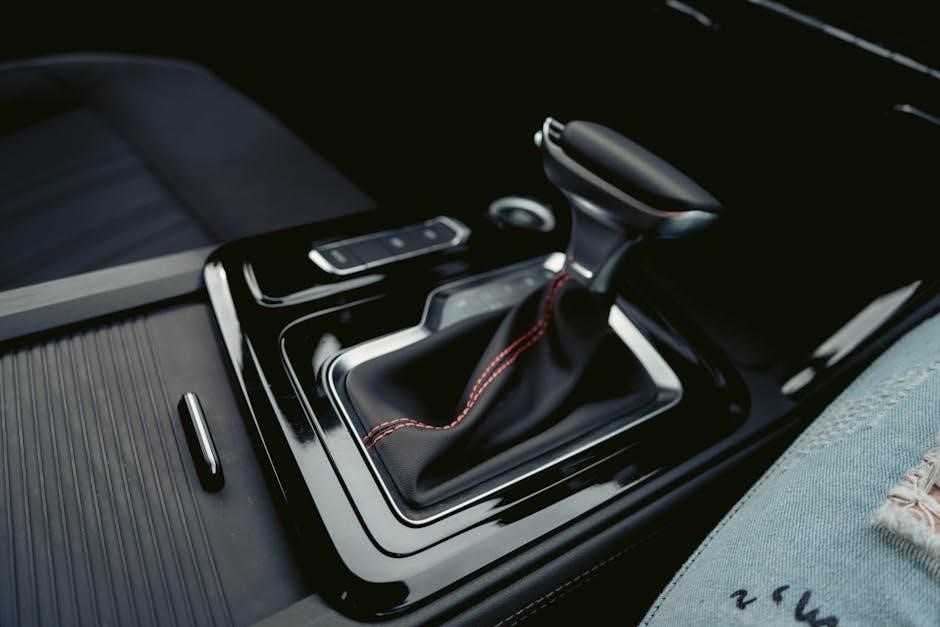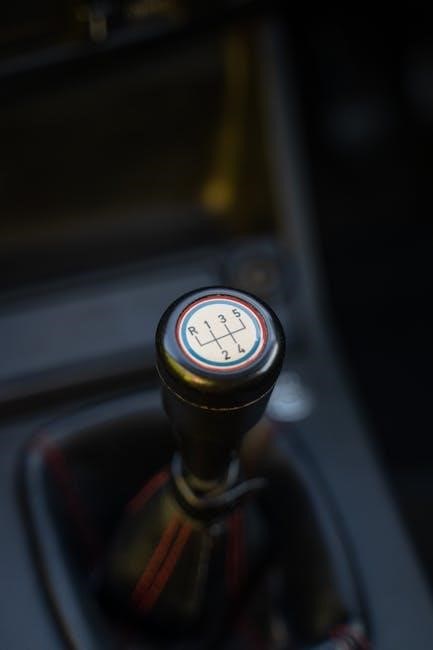Embark on a journey to master manual transmission! Our comprehensive driving lessons equip you with skills to confidently handle a stick shift․ Learn to navigate gears․
Understanding the Basics of Manual Transmission
Manual transmission‚ often called a stick shift‚ offers drivers greater control and engagement․ Unlike automatic transmissions‚ manual cars require you to manually shift gears using a clutch pedal and gear stick․ This allows you to select the optimal gear for any driving situation‚ providing a more responsive and connected driving experience․
Learning the basics involves understanding how the engine’s power is transferred to the wheels․ The clutch acts as a connection between the engine and transmission‚ allowing you to smoothly engage and disengage gears․ Mastering this coordination is crucial for smooth starts‚ stops‚ and gear changes․ Manual transmissions typically feature four to seven forward gears‚ plus reverse․

Essential Controls and Components
Familiarizing yourself with essential controls is paramount․ These include the clutch‚ gear stick‚ accelerator‚ and brake pedals․ Coordination among these components is key to mastering manual driving․
The Clutch Pedal: Function and Operation
The clutch pedal is your gateway to controlling power flow in a manual car․ Understanding its function is fundamental․ Primarily‚ it disconnects the engine from the transmission‚ allowing you to change gears smoothly․
Pressing the clutch pedal fully disengages the engine‚ while releasing it gradually re-engages it․ This process requires finesse to avoid stalling or jerky movements․ The clutch is essential for starting‚ stopping‚ and changing gears․
Learning the “friction point‚” where the engine starts to connect‚ is crucial․ Mastering clutch control is key to smooth transitions․ With practice‚ you’ll develop the muscle memory to seamlessly operate the clutch in conjunction with other controls․
In essence‚ the clutch pedal is the heart of manual transmission‚ enabling gear changes and overall vehicle control․ Proper operation of the clutch is vital for safe and efficient driving with a manual gearbox․
The Gear Stick: Understanding Gear Positions
The gear stick‚ or gearshift lever‚ is your direct interface for selecting gears in a manual transmission vehicle․ Familiarizing yourself with the gear positions is crucial for smooth driving․
Typically‚ a gear stick displays a pattern indicating the location of each gear‚ including reverse․ Understanding this pattern is the first step․ Each gear provides a different level of torque and speed․ First gear is for starting‚ while higher gears are for cruising at higher speeds․
Neutral is a disengaged state where no gear is selected‚ allowing the engine to run freely․ Reverse gear enables backing up․ Shifting between gears requires a coordinated movement involving the clutch and the gear stick․
Practice is essential to develop the muscle memory for accurately selecting gears without looking․ With experience‚ you’ll instinctively know the location of each gear‚ leading to smoother and more confident driving with a manual transmission․
The Accelerator and Brake Pedals: Coordination is Key
In a manual transmission car‚ mastering the coordination between the accelerator and brake pedals is paramount for safe and smooth driving․ Unlike automatic cars‚ you can’t just rely on one pedal․
The accelerator controls the engine’s power output․ Pressing it increases engine speed‚ providing more power to the wheels․ The brake pedal applies the brakes‚ slowing down or stopping the vehicle․ The key lies in using these pedals in conjunction with the clutch․
When slowing down‚ depress the clutch before or as you apply the brakes to prevent stalling․ When accelerating from a stop or during gear changes‚ smoothly coordinate releasing the clutch while pressing the accelerator․
Jerky movements or abrupt pedal transitions can lead to stalling or a rough ride․ Consistent practice will help you develop the necessary finesse and coordination‚ ensuring seamless control over the vehicle’s speed and stability․ This will lead to a much better driving experience․
Starting and Stopping a Manual Car
Starting and stopping a manual car requires a specific sequence․ This involves clutch control‚ gear selection‚ and smooth pedal operation․ Learn the correct procedure for seamless transitions․
Starting the Engine: The Correct Procedure
The initial step to driving a manual car involves mastering the engine start procedure․ Ensure the car is in neutral‚ confirmed by the gear stick’s free movement․ Depress the clutch pedal fully‚ this action disengages the engine from transmission․ Turn the ignition key or press the start button․ Listen for the engine to turn over and smoothly idle․
Avoid releasing the clutch too quickly‚ potentially stalling the engine․ If the engine fails to start‚ repeat the process․ Once started‚ maintain pressure on the clutch until you are ready to engage first gear․ This prevents unexpected movement․ Always ensure the parking brake is engaged before starting․ Familiarize yourself with your car’s specific starting nuances for consistent results․ Remember safety is first․
Smoothly Engaging First Gear and Moving Off
After starting the engine‚ smoothly engaging first gear is crucial for a controlled start․ With the engine running and the clutch fully depressed‚ gently move the gear stick into the first gear position․ Slowly release the clutch while simultaneously applying a small amount of pressure on the accelerator pedal․
Listen to the engine’s sound‚ as it will provide cues․ Find the ‘friction point‚’ where the car begins to move forward․ Maintain balance between clutch release and acceleration․ Avoid releasing the clutch too quickly‚ which can stall the engine․ If stalling occurs‚ fully depress the clutch and restart․ Gradual practice will develop needed muscle memory․ A smooth start is essential․
Stopping the Car: Controlled Braking and Clutch Use
Stopping a manual car requires coordinated use of the brake and clutch pedals․ As you approach your desired stopping point‚ gently apply the brake pedal․ Downshift through the gears as speed decreases to prevent engine strain․ Before the engine speed drops too low‚ fully depress the clutch pedal to disengage the engine from the wheels․
Continue applying the brake smoothly until the car comes to a complete stop․ Avoid abrupt braking‚ which can cause skidding․ Keep the clutch pedal depressed while stationary to prevent stalling․ Once stopped‚ engage neutral gear or keep the clutch depressed․ Practice makes perfect in mastering smooth‚ controlled stops‚ ensuring both safety and comfort․

Mastering Gear Changes
Gear changes are fundamental to driving a manual car․ Smooth transitions between gears optimize engine performance and fuel efficiency․ Learn the art of seamless upshifting and downshifting for a better driving experience․
Upshifting: Timing and Technique
Upshifting in a manual car involves shifting to a higher gear․ This is usually done as the vehicle gains speed․ The key to smooth upshifting lies in coordinating the clutch‚ accelerator‚ and gear stick․ Listen to the engine sound‚ it will tell you when to shift․
The tachometer is another key element in timing gear changes․ Ideally‚ you want to upshift when the engine reaches a specific RPM range․ This range varies from car to car but there is a sweet spot․
Technique involves pressing the clutch pedal fully‚ releasing the accelerator simultaneously․ Then swiftly moving the gear stick to the next higher gear․ Release the clutch pedal smoothly while gently pressing the accelerator․ Avoid dumping the clutch‚ it will cause a jerky motion․
Practice is key to mastering the timing and technique of upshifting․ With practice‚ upshifting will become second nature․
Downshifting: Matching Engine Speed and Gear
Downshifting in a manual transmission car is the process of shifting to a lower gear․ It is typically done to increase engine power․ This is useful for climbing hills‚ overtaking‚ or slowing down․
A crucial aspect of downshifting is matching the engine speed to the lower gear․ This is often achieved through a technique called “rev-matching”․ Rev-matching prevents jerky downshifts and maintains vehicle stability․
To rev-match‚ depress the clutch pedal‚ shift into the lower gear‚ and blip the accelerator pedal․ This will raise the engine RPM to match the speed of the lower gear․ Then‚ smoothly release the clutch pedal․
Downshifting smoothly requires practice and coordination․ Listen to the engine‚ feel the car’s response‚ and adjust your technique accordingly․ The goal is to create a seamless transition between gears‚ avoiding any sudden jolts or loss of control․

Advanced Techniques
Elevate your manual driving skills with advanced techniques․ Master hill starts to prevent rollback and learn precise reverse parking․ These skills enhance your control and confidence․
Hill Starts: Preventing Rollback
Hill starts in a manual car can be daunting‚ but mastering the technique ensures safety and confidence․ The primary concern is preventing rollback‚ which happens when the car rolls backward while attempting to move forward on an incline․
To execute a smooth hill start‚ coordinate the clutch‚ accelerator‚ and brake․ Begin by applying the handbrake or using the “heel-toe” method․ With the handbrake engaged‚ find the biting point of the clutch – the point where the engine starts to engage with the transmission․
Gently increase the accelerator while slowly releasing the clutch and disengaging the handbrake․ The goal is to balance the engine’s power with the clutch engagement to prevent stalling or rolling back․ Practice this coordination until it becomes second nature․
For the heel-toe method‚ use your heel to gently press the accelerator while keeping your toes on the brake․ This allows for a smoother transition and better control‚ especially on steeper inclines․ Consistent practice is key to mastering hill starts and preventing unwanted rollback․
Reverse Parking: Precision and Control
Reverse parking in a manual car demands precision and control․ It requires coordinating the clutch‚ accelerator‚ brake‚ and steering while maintaining awareness of your surroundings․ Start by signaling your intention to park and checking your mirrors for pedestrians and other vehicles․
Position your car parallel to the space you intend to park in‚ leaving enough room to maneuver․ Slowly reverse‚ using the clutch to control your speed․ Precise steering is crucial; turn the wheel sharply in the direction you want the car to go‚ making constant adjustments to maintain the correct angle․
Use reference points‚ such as the car beside you‚ to guide your movements․ Keep a close watch on your mirrors and blind spots to avoid collisions․ As you straighten the car within the parking space‚ use gentle acceleration and clutch control to make small adjustments․
If necessary‚ pull forward slightly to correct your position․ The key is to remain calm and patient‚ making small‚ controlled movements rather than jerky ones․ With practice‚ you’ll develop the finesse needed for perfect reverse parking․

Practice and Professional Guidance
Consistent practice is key to mastering manual transmission․ Professional driving lessons offer invaluable benefits․ They provide structured learning‚ expert guidance‚ and personalized feedback‚ accelerating your progress and building confidence․
The Importance of Consistent Practice
Mastering a manual transmission vehicle demands more than theoretical knowledge; it necessitates consistent‚ dedicated practice․ Repeatedly engaging with the clutch‚ gear stick‚ and pedals refines your muscle memory‚ leading to smoother transitions and improved coordination․ Regular practice sessions allow you to internalize the nuances of gear shifting‚ clutch control‚ and throttle modulation‚ ultimately transforming these complex actions into second nature․
Consistent practice builds confidence and reduces hesitation․ It provides the opportunity to experiment with different techniques‚ identify areas for improvement‚ and fine-tune your skills in a controlled environment․ The more you practice‚ the more adept you become at anticipating the car’s needs and responding accordingly․
Moreover‚ consistent practice helps you to develop a feel for the car‚ recognizing subtle cues such as engine sounds and vibrations․ This intuitive understanding enhances your ability to drive safely and efficiently in diverse driving conditions․ Ultimately‚ dedication to consistent practice is the cornerstone of becoming a proficient manual transmission driver․
Benefits of Professional Driving Lessons
While independent practice is valuable‚ professional driving lessons offer significant advantages when learning manual transmission․ Certified instructors provide structured guidance‚ personalized feedback‚ and a safe learning environment‚ accelerating your progress and minimizing bad habits․ They possess in-depth knowledge of driving techniques‚ traffic laws‚ and safety regulations‚ ensuring you receive comprehensive training․
Professional lessons offer a structured curriculum that systematically covers essential skills‚ from basic clutch control to advanced maneuvers like hill starts and reverse parking․ Instructors can identify your specific weaknesses and tailor their teaching methods to address them effectively․ Furthermore‚ they provide constructive criticism and encouragement‚ boosting your confidence and motivation․
Learning from a professional reduces the risk of developing incorrect techniques that could lead to accidents or damage to the vehicle․ Instructors teach you the proper use of the clutch‚ gear stick‚ and pedals‚ preventing premature wear and tear on the car’s components․ Moreover‚ professional lessons instill a strong foundation in defensive driving practices‚ equipping you with the skills to anticipate and avoid potential hazards․ Investing in professional instruction is a wise choice that pays dividends in terms of safety‚ skill‚ and long-term driving proficiency․
